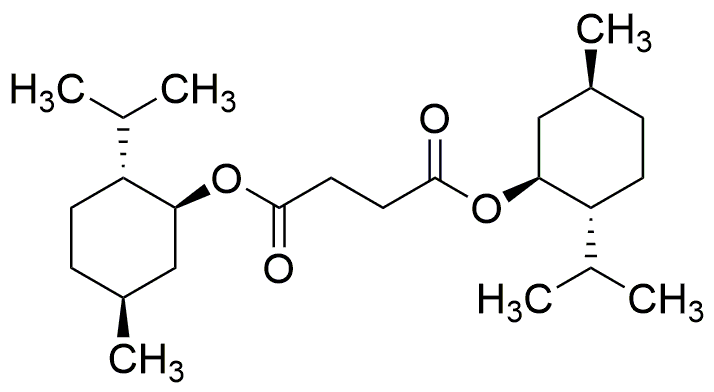(1S)-(+)-Dimenthyl succinate is widely utilized in research focused on
- Flavor and Fragrance Industry: This compound is used as a flavoring agent in food products and as a fragrance component in cosmetics, providing a pleasant aroma and taste that enhances consumer appeal.
- Pharmaceutical Applications: It serves as an intermediate in the synthesis of various pharmaceutical compounds, helping to create effective medications with improved bioavailability.
- Polymer Production: The chemical is employed in the production of specialty polymers, contributing to materials with desirable properties such as flexibility and durability, which are essential in packaging and automotive industries.
- Biochemical Research: Researchers utilize it in studies related to metabolic pathways and enzyme activity, aiding in the understanding of biochemical processes and potential therapeutic targets.
- Cosmetic Formulations: It is incorporated into skincare products for its emollient properties, enhancing skin feel and moisture retention, making it a popular choice among formulators.
Informations générales
Propriétés
Sécurité et réglementation
Applications
(1S)-(+)-Dimenthyl succinate is widely utilized in research focused on
- Flavor and Fragrance Industry: This compound is used as a flavoring agent in food products and as a fragrance component in cosmetics, providing a pleasant aroma and taste that enhances consumer appeal.
- Pharmaceutical Applications: It serves as an intermediate in the synthesis of various pharmaceutical compounds, helping to create effective medications with improved bioavailability.
- Polymer Production: The chemical is employed in the production of specialty polymers, contributing to materials with desirable properties such as flexibility and durability, which are essential in packaging and automotive industries.
- Biochemical Research: Researchers utilize it in studies related to metabolic pathways and enzyme activity, aiding in the understanding of biochemical processes and potential therapeutic targets.
- Cosmetic Formulations: It is incorporated into skincare products for its emollient properties, enhancing skin feel and moisture retention, making it a popular choice among formulators.
Documents
Fiches de données de sécurité (FDS)
La FDS fournit des informations de sécurité complètes sur la manipulation, le stockage et l’élimination du produit.
Spécifications du produit (PS)
Le PS fournit une description complète des propriétés du produit, notamment sa composition chimique, son état physique, sa pureté et les exigences de stockage. Il détaille également les plages de qualité acceptables et les applications prévues du produit.
Certificats d'analyse (COA)
Recherchez des certificats d'analyse (COA) en saisissant le numéro de lot du produit. Les numéros de lot et de lot se trouvent sur l'étiquette d'un produit, après les mots « Lot » ou « Lot de fabrication ».
Numéro de catalogue
Numéro de lot/série
Certificats d'origine (COO)
Ce certificat d'exploitation confirme le pays dans lequel le produit a été fabriqué, et détaille également les matériaux et composants utilisés et s'il est issu de sources naturelles, synthétiques ou autres sources spécifiques. Ce certificat peut être requis pour les douanes, le commerce et la conformité réglementaire.
Numéro de catalogue
Numéro de lot/série
Fiches de données de sécurité (FDS)
La FDS fournit des informations de sécurité complètes sur la manipulation, le stockage et l’élimination du produit.
DownloadSpécifications du produit (PS)
Le PS fournit une description complète des propriétés du produit, notamment sa composition chimique, son état physique, sa pureté et les exigences de stockage. Il détaille également les plages de qualité acceptables et les applications prévues du produit.
DownloadCertificats d'analyse (COA)
Recherchez des certificats d'analyse (COA) en saisissant le numéro de lot du produit. Les numéros de lot et de lot se trouvent sur l'étiquette d'un produit, après les mots « Lot » ou « Lot de fabrication ».
Numéro de catalogue
Numéro de lot/série
Certificats d'origine (COO)
Ce certificat d'exploitation confirme le pays dans lequel le produit a été fabriqué, et détaille également les matériaux et composants utilisés et s'il est issu de sources naturelles, synthétiques ou autres sources spécifiques. Ce certificat peut être requis pour les douanes, le commerce et la conformité réglementaire.


